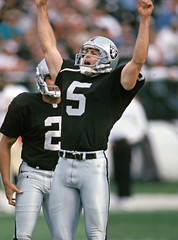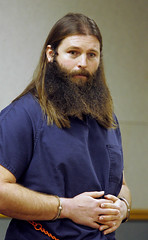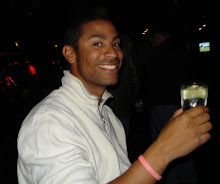Fall from glory
I read this story... thought it was interesting... I'm ashamed to say I don't remember this guy too well, although I claim to be a trueblooded Raiders fan..
So how do you go ...
... from this ...
... to this? Read on ...
From NFL to a mental facility, the rise and fall of a troubled kicker
By Christina Almeida
LAS VEGAS (AP) — Cole Ford took the field at old Tampa Stadium as the clock ticked down to the last nine seconds of the fourth quarter.
It was 1996, and the playoff hopes of an entire Raider Nation rested on the one-time water boy for a youth football league. The Oakland Raiders, 4-5, were at a critical moment in their season if they were to have any hope of making the playoffs for the first time in three years.
Ford had blown a 30-yard field goal the week before in a Monday night game against Denver. This time, with the score tied, he set up for an easy 28-yarder.
Perhaps overcompensating, Ford’s kick sailed left, and Oakland lost in overtime. The 23-year-old Ford, in his second professional season, faced harsh criticism.
“From that short a distance, I’d better make it,” Tampa Bay kicker Michael Husted said, “or not plan on showing up here on Monday morning.”
Ford would make it back the next day and for one more dismal season. And then the bright lights of the gridiron faded, and Ford would fall further than anyone could imagine.
———
The call came in at 6:15 p.m. Shots fired outside the Las Vegas home of entertainers Siegfried & Roy. Buried beneath long hair and an even longer beard, the shooter was almost unrecognizable.
———
Handsome and self-assured, Ford arrived at Southern California in the fall of 1991 ready to tackle the demands of one of the nation’s most prestigious college football programs.
Ford knew well the pressure of big games. He won the state championship his senior year at Sabino High School. The Sabercats of Tucson, Ariz., were ranked 17th in the nation, and Ford alternated between kicker and defensive end.
“He smiled more than any person I know,” said Ford’s high school football coach, Jeff Scurran. “He had a lot to smile about. Good family. Good life.”
The youngest of three boys, Ford grew up on a ranch surrounded by horses and other livestock. His love of football began early as a Tucson Youth Football water boy.
At Sabino, Ford was an all-American athlete with good looks and good grades. Scurran said Ford was remarkably grounded for his age. He made friends easily.
“Here’s a guy who looked about as together as you could be,” Scurran said.
———
It was not uncommon for cars to slow down as they passed the sprawling Jungle Palace estate owned by Siegfried & Roy, the Las Vegas duo known for their mix of magic and exotic animals.
But as the sun began to set on Sept. 21, 2004, the white van shattered the residential calm. Obscenities poured out of the slow-moving van, then blasts from a 12-gauge shotgun sprayed the entrance.
———
At USC, Ford had a reputation for being upbeat, hard-working and extremely talented.
The Trojans, on the heels of back-to-back bowl appearances, struggled during Ford’s first two seasons. Then coach John Robinson arrived in 1993, ready to restore glory to the USC campus.
Robinson had led the Trojans to a national championship in 1978 — and expectations were high.
In Ford’s senior year the Trojans beat Texas Tech 55-14 in the Cotton Bowl. Ford hit a career-best 42-yard field goal and his seven extra points were a Cotton Bowl record.
“Kicking in college takes a lot of strength mentally. You have to be focused,” Ford said in a 1991 interview. “But I like a challenge and I’ve always been someone who likes a challenge. I want to be the man who does the job.”
Ford was so driven, his special teams coach tried to make sure the young kicker didn’t push himself too far.
“No question, he had one of the strongest legs in the country,” coach Jeff Kearin said. “He had such power kicking the ball that he put great stress on his body.”
At one point, injuries slowed Ford — something Kearin believes was brought on by excessive training.
“He really wanted to be great,” Kearin said.
———
When the gunshots rang out, Gregory Garrett was loading construction equipment outside the estate of Siegfried Fischbacher and Roy Horn. Before the white van disappeared, Garrett wrote down its licence plate number.
The police call went out. Cole Ford was a wanted man.
———
Selected by the Pittsburgh Steelers in the seventh round of the 1995 NFL draft, Ford was released during training camp but quickly picked up by the Oakland Raiders. At six foot two and 210 pounds, Ford was an attractive prospect.
With the team’s No. 1 kicker, Jeff Jaeger, sidelined by a sprained knee, Ford hit a 46-yard field goal in the Raiders’ opener against San Diego. Jaeger returned to reclaim the top spot that season, but Ford would challenge the 10-year veteran for the job through the 1996 training camp and pre-season.
Jaeger’s subsequent release from Oakland elicited a sharp reaction from fans and sportswriters, especially after Ford’s missed kick against Tampa Bay. Critics complained that if the Raiders had kept Jaeger instead of Ford, they might have been 6-4 and in the middle of the playoff race.
The NFL can be an unforgiving place for kickers, who sometimes are released after a single missed kick and often bounce from team to team.
“It gets hard,” Ford said after the Tampa Bay loss. “The last two weeks I’ve been the factor in the game.”
Ford played on, but struggled. He made little more than half his field goals the next year and was cut by the Raiders before the 1998 season. He was picked up by the Buffalo Bills but quickly released as the team struggled.
———
The anonymous tip came 11 days after the shooting: The man wanted in the Siegfried & Roy attack was at a Kinko’s shop off the Las Vegas Strip. Police arrested Ford, who was charged with numerous felonies, including assault with a deadly weapon.
A judge ordered a psychiatric evaluation.
———
After being abandoned by a sport he’d loved since childhood, Ford sought refuge at a family home in Lake Tahoe, doing carpentry and masonry work.
But he distanced himself from family and friends, and his behavior grew bizarre. At one point he took family photographs and burned them.
Former Oakland teammate Lincoln Kennedy recalled seeing Ford some years after the young kicker was released from the team. Ford was almost unidentifiable, wearing a camouflage jacket and looking “like Grizzly Adams,” Kennedy said.
Looking back, Kennedy said Ford was different.
“In all honesty, no one was able to put their finger on it because we didn’t know a lot about this guy until after he left,” Kennedy said.
Ford says he travelled the world, living off his NFL earnings. Visiting Mexico, Egypt, Greece and Italy, Ford tried to make sense of his life.
His travels took him to Las Vegas, where he turned his focus to sports bookmaking operations at casinos. In January 2004, Ford filed a $5-million US suit against the Monte Carlo hotel-casino, claiming the casino industry took advantage of athletes.
“Sports gaming is placing challenges on athletes beyond a college and professional experience,” Ford wrote. “I believe gaming is stealing from (an athlete’s) earning potential. The athlete is creating the results and the sports books are claiming them.”
The lawsuit was dismissed.
———
Dr. Norton Roitman examined Ford on Nov. 10, 2004, and diagnosed the 32-year-old with an unspecified psychotic disorder. Ford told the psychiatrist that while watching Siegfried & Roy he realized “what was wrong with the world was linked to the illusionists’ treatment, dominance and unhealthy intimacy” with their animals, Roitman wrote in his report.
“He felt they threatened (the) world, and he began trying to figure out how he could stop them.”
An obstinate Ford later appeared in a Las Vegas courtroom, demanding to plead guilty to the shooting. Instead, the judge ruled he was incompetent to stand trial and sent him to the state’s mental facility in northern Nevada.
“I’m perfectly competent,” Ford told the judge in January.
———
How Ford went from the NFL to a mental institution remains a mystery.
Doctors say it’s likely Ford began showing symptoms of mental illness in his late teens, but his former coaches say they saw nothing.
“It came so far out of left field,” said Kearin, the former USC coach. “I could have named 10 guys who would have lost it and done something like this. Not Cole Ford.”
Most family members declined comment. His mother, Amy Ford, said in a brief phone conversation that it has been years since she saw her son. She hopes he gets the help he needs.
“Nobody truly understands how this stuff happens,” said high school coach Scurran, who is a close friend of the family. “If we knew that, we would probably be on a much better path of curing this. . . . Everyone wants to find a trigger point, but based on some of our conversations, nobody knows.”
In late September, a judge ordered doctors to medicate Ford, who faces up to 27 years in prison if convicted.
Ford, in two phone interviews late this summer, said he was doing well and still wants to plead guilty.
“I accept my charges,” he said. “I’m excited to have a felony on my record. I’m interested to see what the people have to say to see a man with a perfect record have a felony. I’m a perfect citizen. I have a perfect work history.”
Ford reiterated his fear of Siegfried & Roy, calling them “some of the most dangerous people in our country.” He also was sharply critical of the NFL.
“NFL players are much in the environment of the Roman Coliseum. A lot of sacrificing takes place,” Ford said. “It’s possible I didn’t want to become a successful athlete because maybe then I would have been sacrificed.”




0 Comments:
Post a Comment
Subscribe to Post Comments [Atom]
<< Home